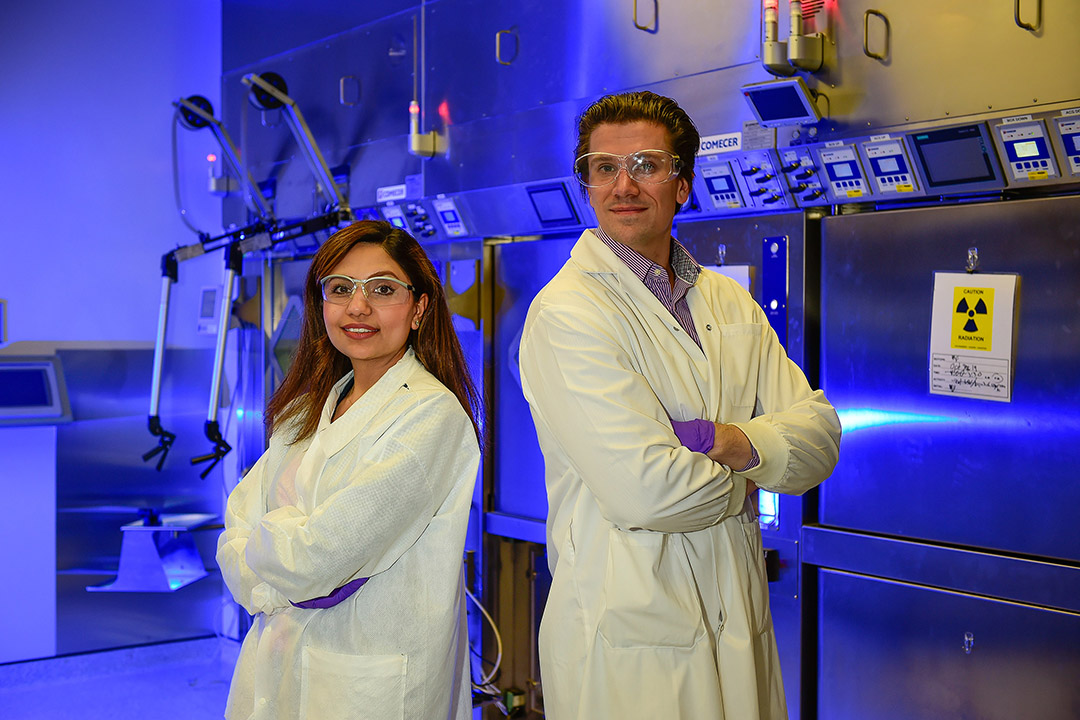
U of S researcher aims to improve cancer detection and treatment
University of Saskatchewan researcher Eric Price wants to use chemistry to solve pressing issues in human health.
By Shannon BoklaschukPrice, an assistant professor in the College of Arts and Science’s Department of Chemistry, is currently examining how to improve radiopharmaceuticals, the radioactive drugs that can be used to detect or treat cancers. He was recently awarded a $120,000 Establishment Grant from the Saskatchewan Health Research Foundation (SHRF) to support his research as he looks into developing novel radiopharmaceuticals that are more effective and have fewer negative side effects.
“The ideal outcome of this work would be the discovery, patenting and clinical translation of a new family of radioactive peptide drugs. The purpose of these new radioactive drugs will be to reduce the side effects of existing drugs while simultaneously improving treatment results for radionuclide therapy, and particularly for difficult-to-treat hypoxic tumours,” said Price, noting that any future clinical trials are a long time away, but would ideally be performed in Saskatoon at Royal University Hospital.
“The timeline for this type of work is very long, with drug companies typically taking seven to 15 years from initial discovery to clinical approval for a brand-new agent – and so these are very long-term goals. A realistic goal to achieve by the end of the three years of funding that is generously being provided by this SHRF grant would be the synthesis and identification of two to four new ‘lead’ compounds that could be patented. These compounds would then be brought forward into more advanced pre-clinical and, then clinical, testing.”
An existing radioactive peptide agent currently used in cancer detection and treatment is called 68Ga-DOTA-TATE, which was approved by the U.S. Food & Drug Administration (FDA) in 2016. It is a radioactive peptide that allows clinicians to collect 3D nuclear images via positron emission tomography (PET) scans of neuroendocrine tumours. Another version of the same compound, 177Lu-DOTA-TATE, was even more recently approved by the FDA in 2018 for radionuclide therapy of the same types of tumours.
Price said people are currently working to get these radioactive drugs approved in Canada, and they have been used in Europe for several years. A drawback of the agents, however, is the high uptake and retention in the kidneys, which negatively affects the quality of the PET images and, in some cases, can also cause radiation damage to patients’ kidneys.
Price and his research team, which includes post-doctoral fellow Elaheh Khozeimeh Sarbisheh and graduate student Shvan Raheem, are attempting to insert a new chemical linkage into the radioactive peptide drug – like a new molecular chain that tethers the radionuclides to the peptide – which aims to block and reduce the high kidney uptake.
“Currently clinicians can give patients other drugs at the same time as these radioactive peptides to try and reduce this kidney uptake and, although effective, the side effects are very unpleasant – and so our approach integrates this into the radioactive drug itself so that only one thing needs to be injected, without side effects,” Price said.
“The second part of the project involves a certain state that tumours often attain called hypoxia, which means they have a lack of blood flow and oxygen. This lack of blood flow and oxygen means they are hard to treat with chemotherapy drugs and radiation therapy, and even harder to see with these cutting-edge radioactive peptide drugs. Using a different type of molecular chain, we are aiming to attach molecules that will help these peptides to get stuck inside of these hypoxic tumours, therefore increasing the quality of images and also the effectiveness of radionuclide therapy,” he said.
“Finally, we are making molecular chains to include fluorescent dyes, which will allow surgeons to visualize tumour margins in real time while performing surgery, which will take a lot of the guesswork out of how big of an area to remove around a tumour and aims to reduce the rates of recurrence as a result of tumour cells being missed during surgery.”
Before coming to the U of S in 2016, Price did a post-doctoral fellowship at Memorial Sloan Kettering Cancer Centre in New York City, where he worked with many different radionuclides for treating and imaging cancer. He moved to Saskatoon to start his research lab in the chemistry department at the U of S and at the Saskatchewan Centre for Cyclotron Sciences (SCCS), which is owned by the U of S and operated and managed by the Sylvia Fedoruk Canadian Centre for Nuclear Innovation.
Price said he is grateful to the U of S, SHRF, the SCCS and the Fedoruk Centre for supporting his research.
“Being multidisciplinary means this work is very expensive and requires access to a large amount of specialized equipment. Without substantial financial support this work would not be possible,” he said.
“I also want to thank the taxpayers for being engaged and supportive of this type of basic and pre-clinical science, as most of the funding institutions that I rely on to operate my research program ultimately come from the provincial and federal government, which, of course, are funded from taxpayers. Although the details of scientific research are often too complicated and specialized to properly explain to the general public, people get really excited about the big-picture ideas and the goals we are working towards.
“One of the great things about nuclear imaging is that everyone ‘gets it’ when they see a PET scan of a person riddled with tumours, and then a follow-up PET scan several months later showing that all of the tumours are gone. Unfortunately, results as dramatic as this aren’t common, but my long-term goals are to make those types of success stories normal rather than exceptional.”

